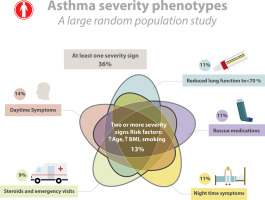Journal of Allergy and Clinical Immunology ( IF 11.4 ) Pub Date : 2017-09-20 , DOI: 10.1016/j.jaci.2017.07.047 Roxana Mincheva , Linda Ekerljung , Apostolos Bossios , Bo Lundbäck , Jan Lötvall

|
Background
The prevalence of asthma severity is not well described at a population level.
Objective
We sought to determine the prevalence of phenotypic signs of asthma severity among asthmatic patients in a general population and to describe risk factors for asthma severity.
Methods
We performed an epidemiologic study conducted between 2008 and 2012 (West Sweden Asthma Study). A postal questionnaire was sent to a random population (n = 30,000) in west Sweden, with 18,087 responses. A total of 2,006 subjects were carefully phenotyped. Only subjects with “active asthma” (symptoms or medication in the last year, n = 744) were analyzed in this study to determine the degree of severity of the disease within an asthma cohort. Phenotypes of severity were calculated based on (1) multiple symptoms during the day despite ongoing use of asthma medications, (2) FEV1 of less than 70% of predicted value, (3) daily or almost daily use of rescue medications, (4) nighttime symptoms once a week or more, and (5) oral corticosteroid use/emergency department visits. Asthmatic patients were grouped as having nonsevere disease, 1 sign of severity, or 2 or more signs of severity.
Results
A total of 36.2% of asthmatic patients expressed at least 1 sign of asthma severity, and 13.2% had 2 or more signs. The group with 2 or more signs was older in age and had higher body mass index, a higher rate of tobacco smoking, and lower lung function. Bronchial hyperreactivity, airway inflammation, and sensitization were significantly different among the 3 groups. At a population level, the prevalence of asthma severity was 3.1% for 1 sign and 1.3% for at least 2 signs.
Conclusion
More than 1 in 3 asthmatic patients show at least 1 sign of asthma severity. The phenotypes of asthma severity are highly diverse, which is important to consider when implementing personalized medicine in asthmatic patients.
中文翻译:

在大量随机人群研究中,严重哮喘的高患病率
背景
在人群水平上,哮喘严重程度的患病率并未得到很好的描述。
客观的
我们试图确定一般人群中哮喘患者中哮喘严重程度的表型征象的流行程度,并描述哮喘严重程度的危险因素。
方法
我们进行了一项在2008年至2012年之间进行的流行病学研究(西瑞典哮喘研究)。已向瑞典西部的一个随机人群(n = 30,000)发送了邮政调查表,答复为18,087。总共对2,006名受试者进行了仔细的表型分析。在这项研究中,仅分析患有“活动性哮喘”(去年出现症状或用药,n = 744)的受试者,以确定哮喘队列中疾病的严重程度。严重程度的表型是根据以下因素计算的:(1)尽管仍在使用哮喘药物,但白天仍出现多种症状,(2)FEV 1少于预期值的70%;(3)每天或几乎每天使用急救药物;(4)每周一次或多次夜间症状;(5)口服皮质类固醇/急诊科就诊。哮喘患者被分类为患有非严重疾病,严重程度为1个迹象或严重程度为2个或更多迹象。
结果
总计36.2%的哮喘患者表现出至少1种哮喘严重程度的体征,而13.2%的患者表现出2种或更多体征。具有2个或更多体征的组年龄较大,体重指数较高,吸烟率较高,肺功能较低。3组之间的支气管高反应性,气道炎症和致敏性显着不同。在人群水平上,哮喘严重程度的患病率为1个征兆为3.1%,至少2个征兆为1.3%。
结论
超过三分之一的哮喘患者显示出至少1种哮喘严重程度的体征。哮喘严重程度的表型高度多样,在哮喘患者中实施个性化药物时要考虑这一点很重要。











































 京公网安备 11010802027423号
京公网安备 11010802027423号